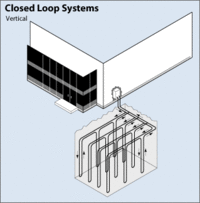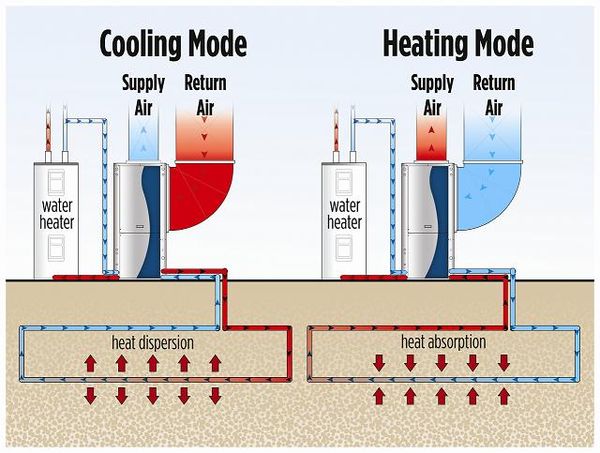Ground source heat pump

Ground source heat pumps, also known as geothermal heat pumps, are highly effective space heating and cooling technologies that extract heat from the ground. Sometimes the source of this heat is the sun (warming the surface and conducting underground), and other times the heat comes from geothermal energy. The ground source heat pumps are literally pumping heat from the ground into a space, often someone's home. Heat can be extracted from any temperature, no matter how cold, however hotter temperatures result in better performance.
Ground source heat pumps can be installed in a home's backyard almost anywhere around the world, however different locations are better suited for their use. For example, the higher the temperature available underground during winter months, the less work the heat pump needs to do.[2]
A main benefit of these systems is that they make use of already available heat that is stored within the Earth, so the heating or cooling for a home does not need to use natural gas or electrical heating. Since ground source heat pumps obtain the energy for heating from the ground, as opposed to conventional systems that require the combustion of fossil fuels or the use of electricity,[3] they have lower fuel costs and lower carbon dioxide emissions during system operation, which will be explored in the environmental impact section below.
Terminology


Geothermal energy originates in the various layers of the Earth, however one has to go a significant depth (10-20 meters or more) before the temperature starts to rise in response to the Earth's internal temperature.[5] Therefore the term "geothermal heat pump" can be misleading since the heat these pumps use is not necessarily geothermal in origin, but rather from the Sun or heat stored in the shallow subsurface, and the term "ground source" is often preferred.
Open loop vs. closed loop systems
Open loop systems, like in figure 2, pull water from underground (groundwater) and then put water back into the ground (cooler water, with the heat taken out), using the heat in the water to warm the living space. By contrast, closed loop systems, see figure 3, use the same fluid repeatedly with the fluid never mixing with the groundwater.
Both systems have advantages and disadvantages, for more information please see The Department of Energy.
Use
Closed loop systems do not rely on an underground water source like other geothermal energy systems, so they can be installed nearly anywhere. Even though the installation price may be greater than the competitive heating technologies, their performance makes up for this cost in 5 - 10 years.[2] Along with a typical lifetime of the system being 25 years, and little to no need for maintenance through its lifetime,[6] these systems generally result in cost savings.
There are around 50 000 of these systems installed in the United States alone each year, with over 3 million currently installed in over 70 countries around the world.[7]
How they work
In the winter, the underground temperatures provide a steady heat source; this means that with the aid of electricity, a ground source heat pump may be used for heating. In the summer, the heat from within the home may be dispelled underground and the pumps may be used for cooling.

They differ from other geothermal energy technologies, as they acquire their heat through direct conduction, whereas geothermal power plants acquire their heat by pumping hot water up to the surface first.[6]
To acquire the heat from the ground, a loop of pipe working as a heat exchanger is buried either horizontally or vertically, depending on how much space the user has available. It contains a fluid (either water, or a water-antifreeze mixture) that absorbs heat in the winter, or dispels heat in the summer. This fluid circulates up to the heat pump, which takes the heat from the underground pipe and uses it for heating purposes in the winter, while in the summer it takes heat from the house and transfers it underground.[2]
20 years' experience with these systems has shown that a few kilowatts of thermal power can be extracted during heating season, suited for the domestic scale.[6]
The video below shows the process of installing a ground source pump, along with its operation.[2] To learn how the heat pump itself works, visit the page on heat pumps.
Environmental Impact
Ground source heat pumps use energy effectively, and are often cost-effective and clean systems. They use 25% to 50% less electricity to run compared to conventional heating and cooling systems, and for every unit of electricity they can get over three units of heat (a COP over 3).[9]
CO2 emissions from these systems can be up to 40% less than other heating or cooling systems. Even better, if the electricity was generated by a renewable energy source, such as a house's solar panels, then there are zero greenhouse gas emissions during the system's operation (however, there are indeed GHGs associated with manufacture, installment, decommission, etc).[6]
Even though the electricity is not always produced from a GHG-free source, the emissions associated with ground source heat pumps is still almost always less than conventional heating/cooling systems. Ground source heat pumps always produce less carbon dioxide emissions than air conditioners, oil burning furnaces and electric heaters, however natural gas heaters may be cleaner depending on where the local electricity supply is coming from (for example, electricity from the use of coal).[10]
References
- ↑ Wikimedia Commons [Online], Available: https://commons.wikimedia.org/wiki/File:Geothermal_shilsholepointe.jpg#/media/File:Geothermal_shilsholepointe.jpg
- ↑ 2.0 2.1 2.2 2.3 Department of Energy. (August 12, 2015). Geothermal Heat Pumps [Online], Available: http://energy.gov/energysaver/articles/geothermal-heat-pumps
- ↑ Department of Energy. (August 12, 2015). Geothermal Heat Pumps [Online], Available: http://energy.gov/eere/geothermal/geothermal-heat-pumps
- ↑ 4.0 4.1 Department of Energy Heat & Cool - Geothermal heat pumps [Online, accessed August 28th, 2017.], Available: https://energy.gov/energysaver/geothermal-heat-pumps
- ↑ R. Wolfson, "Geothermal Heat Pumps" in Energy, Environment, and Climate, 2nd ed., New York, NY: W.W. Norton & Company, 2012, ch. 8, sec. 4, pp. 214-218
- ↑ 6.0 6.1 6.2 6.3 G. Boyle. Renewable Energy: Power for a Sustainable Future, 2nd ed. Oxford, UK: Oxford University Press, 2004.
- ↑ International Energy Agency. (Written 2010, accessed August 28, 2017). Renewable Energy Essentials: Geothermal [Online], Available: http://www.iea.org/publications/freepublications/publication/Geothermal_Essentials.pdf
- ↑ This image shows up on a number of websites, we couldn't figure out the original author, but took the image from Energyhomes.org's website 'What is a Geothermal Heat Pump', available: http://www.energyhomes.org/renewable-technology/howgeoworks.html [Online, accessed August 28th, 2017.]
- ↑ US Department of Energy. (August 12, 2015). Choosing and Installing Geothermal Heat Pumps [Online], Available: http://energy.gov/energysaver/articles/choosing-and-installing-geothermal-heat-pumps
- ↑ J Hanova and H Dowlatabadi. (August 12, 2015). Strategic GHG reduction through the use of ground source heat pump technology [Online], Available: http://iopscience.iop.org/1748-9326/2/4/044001/pdf/erl7_4_044001.pdf

